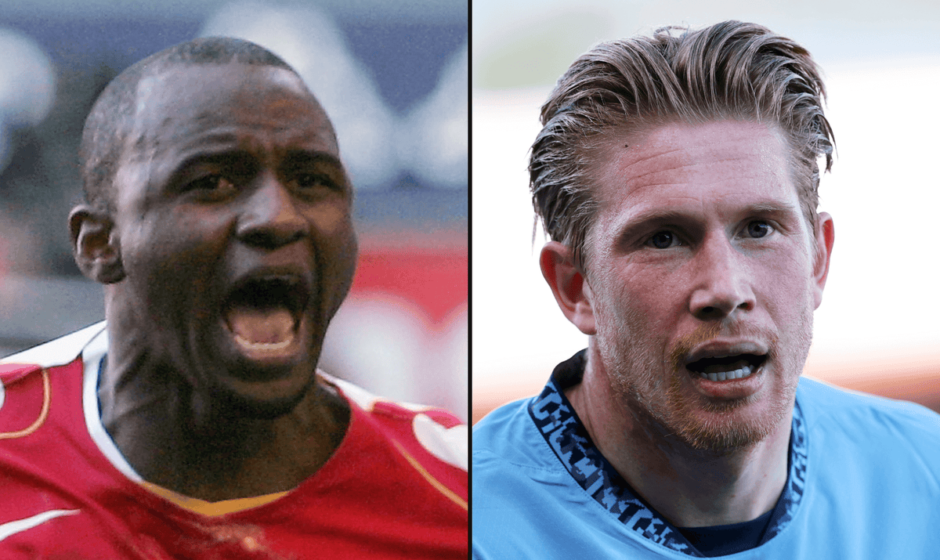“Always I have to be careful for the respect for the players that have played incredible roles, but there’s no doubt he’s one of the greatest for sure,” said Pep Guardiola of Kevin De Bruyne’s impending exit from Manchester City.
De Bruyne’s impact at City since joining from Wolfsburg in 2015 has been huge, with the Belgian scoring 106 goals in 413 appearances, contributing to 187 Premier League goals (scoring or assisting), equalling the assist record for a single season and winning 19 trophies.
While Guardiola was careful about discussing where he stands in the greatest player debate, the City coach praised his “influence in our success in the last decade”.
Which had us asking, who are the most influential midfielders of the Premier League era?
Here is a selection of our writers’ answers and explanations of why they chose them. There probably isn’t a right answer but please let us know who we’ve overlooked (sorry, Paul Scholes) and register your vote in our poll (or submit your own entry).
We’ll publish the results on Sunday.
Yaya Toure
Premier League career: Manchester City 2010-18
Quite simply, Yaya Toure played in a style different to any midfielder the Premier League had seen before. He had the physicality of a centre-back, screening of a No 6, driving ability of a No 8, and shot power of a striker, patch-worked together in one sky blue-clad body.
There was Claude Makelele, who achieved Toure’s defensive coverage but was far more limited in attack, while even Arsenal’s Patrick Vieira lacked the Ivorian’s ability to take games by the scruff of their necks. Mousa Dembele, at his best, probably comes closest.
Here was the player that straddled City’s first post-takeover steps — his goal against Stoke City won the 2011 FA Cup, the club’s first trophy in 35 years — and Pep Guardiola’s dominant sides. David Silva, as wonderful as he was, relied on the industry and guile of his deeper-lying partner.

Toure playing for Manchester City in 2018 (Mike Hewitt via Getty Images)
He is probably the figure who has most influenced the mimetic ideal of a Premier League midfielder, his frame dominating in the most physical league in the world, but his technical ability still allowing him to evade pressure and crash the box. Ask any top-flight manager to draw up the frame and skill set of their ideal midfielder, all rules of creation in their hands, and Toure would be the closest facsimile.
Jacob Whitehead
Frank Lampard
West Ham United 1995-01, Chelsea 2001-14, Manchester City 2014-15
Goals. Lampard scored 177 of them, elevating him to seventh place on the Premier League’s all-time list. To put that into context, he’s surrounded by strikers. The next-highest midfielder — Steven Gerrard — is in 23rd place. Lampard’s assists? 102. Astonishing numbers that highlight Lampard’s incredible attacking output across 22 Premier League seasons, most spent with Chelsea, where he won three Premier League titles after signing from West Ham in 2001.
Lampard’s biggest talent, by his own admission, was his work ethic and dedication. Encouraged by his father, Frank Lampard Snr, he practised relentlessly, striving to be the best that he could be every day at training, and, ultimately, he got his reward.
An elegant passer of the ball, aided by his awareness and football intelligence, Lampard mastered the art of the late run into the penalty area, where he scored goals of every description to establish himself as one of the Premier League greats.
Stuart James
Roy Keane
Nottingham Forest 1990*-93, Manchester United 1993-2005
A force of nature, a supreme competitor. Sir Alex Ferguson once said, “If I was putting Roy Keane out there to represent Manchester United on a one-on-one, we would win the Derby, the Grand National, the Boat Race and anything else.”
Keane was not just part of a dominant team at United in the 1990s and early 2000s, he was the heart and soul.

Keane was United’s on-pitch leader (Michael Steele/EMPICS via Getty Images)
He didn’t play defence-splitting passes like Gerrard, De Bruyne or Paul Scholes. He didn’t have the silky skills of Cesc Fabregas, Luka Modric or Silva. He didn’t score goals like Lampard and he didn’t have the towering presence of Vieira. But he was, in an understated way, an extraordinary footballer — not just a fearsome tackler but a swashbuckling box-to-box midfielder and who evolved into an intelligent and inspirational (if at times impetuous) captain who elevated and at times dragged his team-mates to another level.
Oliver Kay
* 1992-93 was the first Premier League season
Xabi Alonso
Liverpool 2004-09
As if it wasn’t enough to be so good that Jose Mourinho compared you to a “metronomic” Guardiola. No, Alonso could also do the audacious to sit alongside the elegantly procedural midfield demands.
He scored in a Champions League final, won the FA Cup and shared the limelight with Gerrard in his prime. But the Basque midfielder will also be remembered for one of the Premier League’s most ridiculous goals, against Newcastle United at Anfield in September 2006.
Having won the ball himself just outside the centre circle, he saw opposition ‘keeper Steve Harper off his line and duly put the ball into the net from a staggering 60 yards. It was the second-longest goal in top-flight history but remarkably, he had already gone better.
That year, he had scored from more than 70 yards near the end of an FA Cup win at Luton Town after the goalkeeper had gone up for a set piece. The complete range of passing, a penchant to put his foot in when required and capable of jaw-dropping goals — Alonso had it all.
Greg O’Keeffe
Steven Gerrard
Liverpool 1998-2015
Football has become about specialisms, players whose job description is tightly defined around one super-strength. Very few have possessed the ability to claim they are one of the best across all categories.
Vieira, Toure and Rodri all have a case, but those players were usually part of either the best or second-best team in England. Gerrard did not have that luxury in many seasons, yet he is still the best all-rounder there has been. It is why his spectacularly outsized influence on Liverpool was so captivating.
He had power, guile, range, aggression. He was Roy of the Rovers incarnate, a sheer force of nature who could transform games on his own. It is why Jose Mourinho tried to sign him for three different clubs and why Ferguson thought he was the only player who replicated Keane’s ubiquity on the pitch.

Gerrard stayed loyal to Liverpool (AMA/Corbis via Getty Images)
That ferocious energy and desire to be everything was what Rafa Benitez refined. He added a subtlety to his game while playing just off Fernando Torres, producing sublime killer passes on tap. Late in his career, he was reinvented as a ‘quarterback’, pinging diagonals from deep with machine-like precision.
He could have been placed into any team or style and had he not stayed at his boyhood club and racked up titles elsewhere, the conversation would be a lot shorter.
Jordan Campbell
Cesc Fabregas
Arsenal 2003-11, Chelsea 2014-19
He was so good, he changed the way Arsenal played football.
Arsene Wenger’s early success in north London had been built on the pace and power of Vieira, Emmanuel Petit and Gilberto Silva, but when a scruffy 16-year-old with a dodgy mullet and a baggy shirt arrived from Barcelona, a new era began.
After Viera’s departure, Fabregas was given the keys to the Arsenal midfield and grabbed them with both hands. His passing was slick, his vision sublime, and he quickly became the poster boy for what would come to be known as ‘Wengerball’.
He was unlucky to never win the trophies his quality deserved with Arsenal, but he returned from a spell back at Barcelona to win two Premier League titles in three seasons with Chelsea.
Under Wenger, Mourinho and Antonio Conte, the styles were wildly different, but it’s a testament to how good a player he was that Fabregas’ quality always shone through.
Kaya Kaynak
Patrick Vieira
Arsenal 1996-2005, Man City 2010-11
In the Premier League, there was a time before Wenger and a time after he arrived.
And just as Thierry Henry used Wenger’s Arsenal team as a vehicle to redefine the role of a Premier League forward, so Vieira used it to transform the idea of a midfielder.
There had been outstanding box-to-box operators before him, most notably Bryan Robson at the league’s inception in the early 1990s, then Keane. But Vieira was the complete package.

Vieira was key to Wenger’s Arsenal (John Peters/Manchester United via Getty Images)
He could match any midfielder of his era for technique, skill and intelligence while having the edge on everyone else in athleticism, physical presence, stamina and mobility. He could bend games to his will through sheer force of personality and he did it all while gliding across the pitch with a grace that no supreme, 6ft 4in (193cm) athlete should be able to produce.
Steve Madeley
Kevin De Bruyne
Manchester City 2015-2025
It’s not just the relentlessness of De Bruyne’s output that City will miss, but the imagination and variety — the spark — that he consistently found, so often the man with the creative solution that other talented team-mates just couldn’t see.
There were moments of sheer genius — a deft reverse pass to find Leroy Sane in a 7-2 win against Stoke City; a free kick rolled under the wall against Cardiff City, a defence-splitting ball to drag Manchester City back into the game at Newcastle.
There were moments of repeated brilliance — those unstoppable crosses from the right, always struck with whip, venom, and deep into the areas that no opponent wanted to defend. And when all else failed, there was sheer power — searing strikes against Swansea City and Chelsea, a thumping half-volley off the bar at St James’ Park, and a surging, title-winning run into the box against Aston Villa all springing to mind.
On both feet, and with absolutely everything he had, De Bruyne brought a unique mix of brutal efficiency and eye-catching style, a hard-working midfielder with game-breaking talent to boot.
How City will adapt to life without him remains unclear; it’s the same question fans asked when Toure and Silva chose to move on, before a certain Belgian midfielder answered the call.
Leaving with six Premier League titles, five League Cups, two FA Cups and, most importantly, a Champions League to his name, the club have De Bruyne to thank for helping to deliver its finest hours.
Thom Harris
Claude Makelele
Chelsea 2003-08
There are not many football players whose role became so clearly defined that it is named after them.
Makelele arrived at Chelsea in the twilight of his career. Aged 30, Makelele had been converted from an attacking midfielder to a deep-lying, anchoring midfielder that would protect his back line and hoover up any defensive actions that came anywhere near his orbit.
However, it was not just his ability to cover ground and regain possession, but also how much his role transformed the way that Chelsea played on the ball — signalling to the Premier League that a 4-4-2 was becoming increasingly outdated.

Makelele even had a role named after him (Odd Andersen/AFP via Getty Images)
“If I have a triangle in midfield — Claude Makelele behind and two others just in front — I will always have an advantage against a pure 4-4-2 where the central midfielders are side by side,” said Mourinho as Chelsea manager. “That’s because I will always have an extra man. It starts with Makelele, who is between the lines.”
When ‘The Makelele Role’ becomes an established phrase within the game, you know you have made an impact in the Premier League.
Mark Carey
Paul Ince
Manchester United 1989*-1995, Liverpool 1997-99, Middlesbrough 1999-2002, Wolverhampton Wanderers 2003-04 (Ince played in the top flight for West Ham from 1986-89)
Ince was the start of it all. In the inaugural Premier League season (1992-93), Manchester United won their first title in 26 years. Ince played 41 of the 42 games. He made United win matches.
Next season, same again. United won the second ever Premier League season, with Ince playing 39 of 42 matches and scoring eight goals, most of them alongside new arrival Keane.
In the third Premier League season, United were beaten into second place by Blackburn Rovers and Ince’s relationship with Ferguson had soured, so he was sold to Inter Milan for £7.5million ($9.7m at current rates).
A lot was said about Ince, not least by Ferguson, who called Ince a “big-time Charlie” when the midfielder was playing for Liverpool, a comment Ferguson later regretted.
It’s true, Ince did rate himself, but justifiably so. If you supported the opposition, Ince felt unbeatable. He controlled the midfield and controlled the game, the way great Italian midfielders were able to.
He spent two seasons in Serie A before signing for Liverpool. He was past his best then, but before that, Ince was the Premier League’s stepping stone to get to Keane, Vieira and De Bruyne.
Andrew Hankinson
N’Golo Kante
Leicester City 2015-16, Chelsea 2016-23
Kante took the Makelele role and asked for large fries to go with it. He super-sized what it meant to be a ball-winning midfielder (despite his shorter height and slighter frame) and spearheaded consecutive Premier League titles with different clubs.
He arguably achieved a unique feat in being central to two successive title-winning teams. Eric Cantona did something similar with Leeds United and Manchester United in 1992 and 1993, but only joined the former from February onwards when they were already top of the table.

Kante was central to Leicester’s remarkable title (Getty Images)
It is impossible to envisage Leicester winning the title in 2016 without Kante, who did the jobs of two, even three players with his relentless interceptions and tackles. Then at Chelsea a season later, he repeated the feat, scooping up all the player-of-the-year awards along the way.
A World Cup and a Champions League would follow as Kante reimagined himself slightly further up the field. Sadly, injuries stunted his golden era, but at his best, no one in the world was better at what Kante did.
He is also the greatest bargain buy on this list, costing Leicester just £5.6m from French club Caen in 2015
Tim Spiers
David Silva
Manchester City 2010-20
There is an interesting debate to be had between Silva and De Bruyne, purely in terms of their different styles of play. Plenty of City fans will pick Silva as the best player to ever play for the club, and most Spaniards would probably side with Silva due to their different appreciation of what makes a footballer special.
De Bruyne’s game lends itself more to British sensibilities: he is all about powerful running and crash, bang, wallop goals.
Silva was the yin to De Bruyne’s yang. If De Bruyne was the icing on the cake, Silva was the cake.
He made City tick during his entire period at the club, whether it was Roberto Mancini, Manuel Pellegrini or Guardiola in charge. The latter’s game plans are all about controlling the game and Silva’s tempo-setting approach, always knowing how many touches were needed in a given moment, found an obvious home. To sound all hipster for a moment, Silva would be the thinking man’s choice.
Sam Lee
Have your say
(Top image: Getty Images)
#Discussing #Kevin #Bruyne #influential #midfielders #Premier #League #era


